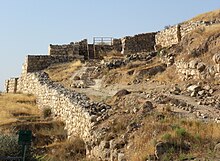
Back لخيش Arabic Лахіш Byelorussian Tel Laquix Catalan Tel Lakhish CEB Lachiš Czech Lachisch German Laquis Spanish Tel Lakix Basque تل لاچیش Persian Lakish French
תל לכיש (in Hebrew) | |
 Main gate of Lachish | |
| Location | Southern District, Israel |
|---|---|
| Region | Shephelah |
| Coordinates | 31°33′54″N 34°50′56″E / 31.56500°N 34.84889°E |
| Grid position | 135/108 PAL |
| Type | Settlement |
| Part of | Canaan, Kingdom of Judah |
| Area | 20 ha (49 acres) |
| History | |
| Abandoned | 587 BCE |
| Periods | Bronze Age, Iron Age |
| Cultures | Canaanite, Israelite, Judahite |
| Events | Siege of Lachish (701 BCE) |
| Site notes | |
| Excavation dates | 1932–1938, 1966, 1968, 1973–1994, 2013–2016 |
| Archaeologists | James Leslie Starkey, Olga Tufnell, Yohanan Aharoni, David Ussishkin, Yosef Garfinkel |
| Condition | Ruined |
| Ownership | Public |
| Public access | Yes |
Lachish (Hebrew: לכיש, romanized: Lāḵîš; Koinē Greek: Λαχίς; Latin: Lachis) was an ancient Israelite city in the Shephelah ("lowlands of Judea") region of Canaan on the south bank of the Lakhish River mentioned several times in the Hebrew Bible. The current tell by that name, known as Tel Lachish (Hebrew: תל לכיש) or Tell el-Duweir (تل الدوير),[1][2] has been identified with Lachish. Today, it is an Israeli national park operated and maintained by the Israel Nature and Parks Authority. It lies near the present-day moshav of Lakhish, which was named in honor of the ancient city.
Lachish was first mentioned in the Amarna letters. In the Book of Joshua, Lachish is cited as one of the cities conquered by the Israelites for joining the league against the Gibeonites (Joshua 10:31–33). The territory was later assigned to the tribe of Judah according to Joshua 15:39 and became part of the united Kingdom of Israel. Following the kingdom's partition, Lachish emerged as one of the most important cities in the Kingdom of Judah, second only to the capital, Jerusalem.[3]
Lachish is best known for its siege and conquest by the Neo-Assyrian Empire in 701 BCE, an event famously depicted on the Lachish reliefs, which can be seen today in the British Museum. According to the Book of Jeremiah, Lachish and Azekah were the last two Judean cities to fall to the Neo-Babylonian Empire before the conquest of Jerusalem according to Jeremiah 34:7. One of the Lachish letters, written in 597–587 BCE, warns of the impending Neo-Babylonian destruction. It reads: "Let my lord know that we are watching over the beacon of Lachish, according to the signals which my lord gave, for Azekah is not seen." This pottery inscription can be seen at the Israel Museum in Jerusalem.[4] The siege ramp at Lachish, designed for deploying battering rams against the city during the Neo-Assyrian siege, is the oldest known in the world and the sole example found in the ancient Near East.[5]
- ^ "State of Israel Records", Collection of Publications, no. 277 (PDF) (in Hebrew), Jerusalem: Government of Israel, 1953, p. 636,
(p. 630) The names of the settlements were mostly determined at different times by the 'Names Committee for the Settlements,' under the auspices of the Jewish National Fund (est. 1925), while [other] names were added by the Government Naming Committee.
- ^ Vermeersch, Shyama; Riehl, Simone; Starkovich, Britt M.; Streit, Katharina; Höflmayer, Felix (2021-02-09). "Animal husbandry from the Middle Bronze Age through the Iron Age in the Shephelah—faunal remains from the new excavations at Lachish". Archaeological and Anthropological Sciences. 13 (3): 38. Bibcode:2021ArAnS..13...38V. doi:10.1007/s12520-021-01289-1. ISSN 1866-9557. S2CID 231850376.
- ^ Cite error: The named reference
Kingwas invoked but never defined (see the help page). - ^ Schaalje, Jacqueline. "Lachish". The Jewish Magazine. Archaeology in Israel.
- ^ Garfinkel, Yosef; Carroll, Jon W.; Pytlik, Michael; Mumcuoglu, Madeleine (November 2021). "Constructing the Assyrian Siege Ramp at Lachish: Texts, Iconography, Archaeology and Photogrammetry". Oxford Journal of Archaeology. 40 (4): 417–439. doi:10.1111/ojoa.12231. ISSN 0262-5253.
© MMXXIII Rich X Search. We shall prevail. All rights reserved. Rich X Search
